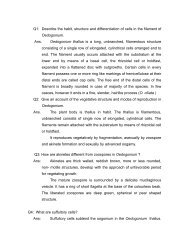Morphology of Marsilea Systematic position Kingdom : Plantae - CEC
Morphology of Marsilea Systematic position Kingdom : Plantae - CEC
Morphology of Marsilea Systematic position Kingdom : Plantae - CEC
You also want an ePaper? Increase the reach of your titles
YUMPU automatically turns print PDFs into web optimized ePapers that Google loves.
Genus : <strong>Marsilea</strong> Linn.<br />
Common Name : Water Fern<br />
The plant body <strong>of</strong> <strong>Marsilea</strong> is sporophytic having diploid chromosome<br />
number in its somatic cells. During sexual reproduction, it produces male and<br />
female gametophytes, which are haploid in nature and form the sperm and<br />
egg, respectively. The sporophyte is differentiated into rhizome, roots, and<br />
leaves.<br />
Rhizome (Stem): The stem is a long and slender rhizome (Fig. 1). It creeps<br />
either on the surface like stolon, or slightly below the surface <strong>of</strong> the soil like<br />
rhizome. It grows extensively and is branched. The branches arise at the<br />
bases <strong>of</strong> petioles and are extra-axillary in <strong>position</strong>, arising in the lateral or<br />
oblique <strong>position</strong>. They run in all directions and may get rooted at the nodes. In<br />
this way, a single plant may cover an extensive area <strong>of</strong> about 20 metre’s<br />
diameter or even more. The stem is divisible into distinct nodes and<br />
internodes. The internodes are long in the hydrophytic species, and short in<br />
the sub-terrestrial or xerophytic species.<br />
Fig. 1 Creeping and slender rhizome <strong>of</strong> <strong>Marsilea</strong> sp.



